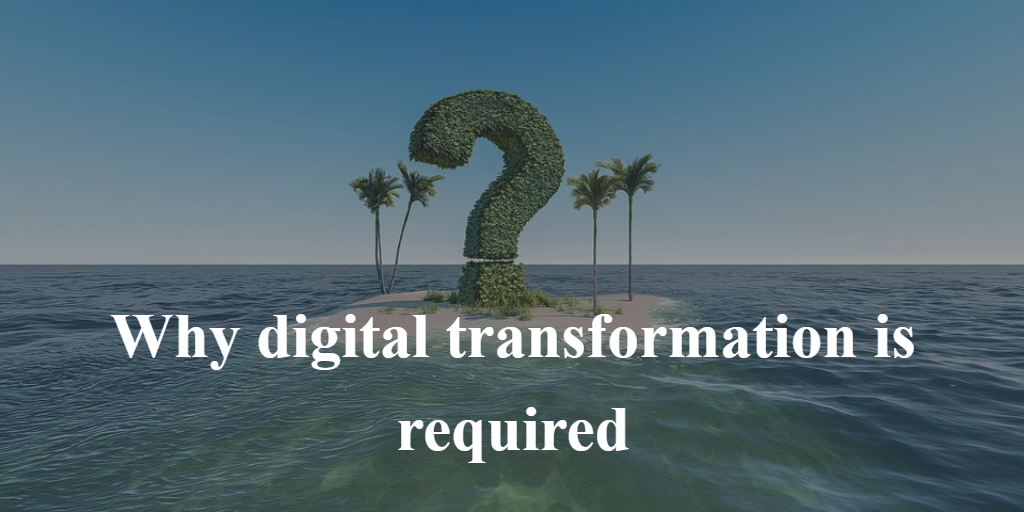
I’m working in a field where I am playing a role in the digital transformation journey of different organizations, being an enterprise architect, where I fully focus on the business outcome based enterprise architecture by modernizing legacy business applications and with the use of emerging technologies to achieve required business outcome. While working with different organizations and stakeholders across the region and witnessing the challenges being faced in digital transformation programs, thought to start from the basics of digital transformation, why all this? Why is it all about digital transformation? Is your organization embracing digital transformation? What is digital transformation? And if you are not working on it, should you?
I have spent considerable hours chunking the wealth of knowledge floating around us to get the answers to these questions. The world has gone digital, and there’s no way to go back. This has created an urgency for all business to digitally transform and be with the world of ‘digital’.
This change presents unique challenges for businesses. If organizations don’t have a clear path forward for digital transformation, we can bravely say that organization may not make it through the next few years. We know businesses are often very slow to change, and many of the advancements that come quickly through our digital world don’t come easily or cheaply.
As we are seeing, reports are being published on the success rate in digital transformation programs. Success and failure patterns are emerging from the early adapters and followers of digital transformation programs.
In a new McKinsey Global Survey on digital transformations published in October 2018 ‘Unlocking success in digital transformations’ it was mentioned that success in these transformations is proving to be elusive. More than eight in ten respondents say their organizations have undertaken such efforts in the past five years and success is vague, indefinable.
Mckinsey’s earlier research done during April 2015 found that fewer than one-third of organizational transformations succeed at improving a company’s performance and sustaining those gains. Now, if we compare this information with the latest results, we see the success rate of digital transformations is even lower.
With these shocking results, I thought to go back to the fundamentals of Digital Transformation and start over….
In this article, I will try to go to the roots of our subject of this century ‘Digital Transformation’ with the following outline:
- What is digital transformation? Learning the basics
- Why digital transformation is required or why we need digital transformation for an organization…
- What are the benefits of digital transformation? Or Why Digital transformation is important

What is digital transformation? Learning the basics
Digital transformation is imperative for all businesses. This message is coming assertively from every conference keynote, panel discussion, article, blog post, or study related to how businesses can remain competitive and relevant as the world becomes digital.
We are witnessing that it’s not yet clear to many business leaders what digital transformation means. Is it just due to the business model where organizations are being pushed to move to the cloud? Why do we need digital transformation? Why is it important? What are the specific steps we need to take? Do we need to hire new roles to help us for digital transformation or engage an external vendor? What parts of our business model need to change? Is it going to impact only technology? What about the business processes/models?
Although I am working in a technology profession where I consider myself a tech geek, a number of questions were still not clear to me, and I was just going with the crowd…yes, ‘digital transformation’ is the hot topic and let’s keep talking about this. So, in pursuit of the truth and clarifying my own beliefs, I thought to go to the basics and start from the foremost question, what is digital transformation?
Before we hit the definition of digital transformation, there is a hype everywhere about ‘digital transformation’. The term is often used but rarely defined. Some leaders feel the term “digital transformation” has become so widely used, so broad, it has become unsupportive. You may have a feeling the term ‘digital transformation’ is overly used or misused. Whether you like it or not, the business mandates behind the term and industry leaders are spending days and nights not only defining the term but actually outlining the ripping benefits of digital transformation on business. This term is challenging the old schools to rethink old operating models, to experiment more, to become more agile in their ability to respond to customers and competitors, which is the primary objective of the business.
Let’s start with a delineation, keeping in mind, if we don’t know what we are trying to achieve, then how do we know how to get there?
I will refer to a famous quote of Yogi Berra: “If you don’t know where you are going, you’ll end up someplace else.”
Whereas we want to reach to the basic understanding of Digital transformation, let’s digest what digital transformation is. Digital transformation programs are different for every organization and every business, so it can be hard to pinpoint a universal definition that applies to all. However, generally, we can define digital transformation as the assimilation of digital technology into all areas of a business, resulting in fundamental changes to how businesses operate and how they serve customers. Further then, it’s a cultural change that requires organizations continually to challenge how things stand, experiment more, and become comfortable with failure.
Now, let’s dive into some formal definitions curated from different sources:
“Digital Business Transformation is Organizational Change through the use of Digital Technologies and Business Models to Improve Performance” as defined by The Global Center for Digital Business Transformation.
As per Gartner, Digital business transformation is the process of exploiting digital technologies and supporting capabilities to create a robust new digital business model.
A definition from The Agile Elephant: “Digital transformation involves a change in leadership, different thinking, the encouragement of innovation and new business models, incorporating digitization of assets and an increased use of technology to improve the experience of your organization’s employees, customers, suppliers, partners and stakeholders.”
In simple words, digital transformation is the reimagining of business in the digital age.

Why is digital transformation required?
So, if we recap the definition…Digital transformation is the process of shifting your organization from a legacy approach to new ways of working and using new, emerging technologies.
Why is digital transformation so important for every business? If we will look through the current lens of businesses and the digital era, we can say that, if your organization is not modernizing, then you will be left behind. This threat of disruption becomes very real when you read success stories of ‘digital’ native or savvy organizations and how they are out blasting the competition. Any company that started a decade ago can be considered not “born in the digital era”, meaning you are probably using legacy software and out of date IT infrastructure. This is not a problem as long as your competition is in the same phase, but your problem is that your competitors now are lean, efficient, and delighting their customers by engaging with them across multiple channels. And as we are seeing in organizations, executives in all industries are using digital technologies, like Analytics, mobility, social media, IOT, AI, and Blockchain, and improving their use of traditional technologies, such as customer relationship management, finance, supply chain, human resources processes, and value propositions.
These organizations are being called ‘Digirati’ – the combination of digital activity with strong leadership to turn technology into transformation by MITSloan management review. This is what MIT Sloan calls Digital Maturity. Companies vary in their digital maturity, and those that are more mature outperform those that are not.
Executives are digitally transforming 3 key areas of their enterprises:
1-Customer experience,
2-Operational processes, and
3-Business models.
And each of these three pillars have different elements that are changing.
What we are seeing …There are new ways to engage with customers, more innovation in the workforce, and more opportunities to harness data insights as just a few of the benefits that digital transformation brings. Now more than ever, an organization’s IT strategies are fundamental to their business strategies. Whatever a company’s vision for the future, it must include digital transformation in order to grow and compete effectively. Digital transformation is constant. In the book Exponential Organizations, Salim Ismail wrote: “Any company designed for success in the 20th Century is doomed for failure in the 21st.”
Therefore, digital transformation is a fundamental rethinking of customer experience, business models, and operations. It’s about finding new ways to deliver value, generate revenue, and improve efficiency, and companies are using innovative technologies to do it.
Let’s go into more detail of the 3 pillars of digital transformation
1- Customer experience,
2-Business models, and
3-Operational processes.
Everyone expects on-demand – it’s all about customer experience
Whether you are using a company’s app, visiting a website, or making an automated phone call, digital is now firmly at the heart of the consumer’s experience with your brand. Whoever gives this ‘experience’ to the consumer the way the consumer wants or the way it inspires the consumer will win the digital transformation race. Therefore, the ‘experience’ needs to be seamless, responsive, and efficient. If you are not able to provide this, your customers will look for your competition without any doubt. Today’s customer, internal or external, expects the same kind of experience they have with technology in their personal lives. According to research by the Consumer Executive Board (CEB), as much as 70% of the buying decision has been made even before talking to a salesperson. So, the learning is we need to have more customer understanding and customer touch points to provide the ‘experience of customer’
Business Models Driven By Digital Technologies
A Business Model is defined by the characteristics of: Value proposition and how it is delivered to the target customers with innovative ways to make money and maximize shareholder value.
These models could be:
- expansion into new industries & markets and you can enter and disrupt other industries or markets by leveraging core assets and capabilities (customers, assets, intellectual property, etc.).
- You can disrupt the entire value chain by rethinking how products and services can be delivered faster and at a lower cost.
Business / Operational Process
Digital capabilities will transform business processes and functions and change the way you do business, deliver on promises, and generate value. You have to delight customers at every ‘touch point’ of their journey from product search to order, delivery, and post sales service. You need to equip your employees to work on real-time information to sense and respond to changes as they occur and empower them to make smart decisions in real time, leveraging insightful data at their fingertips. With the availability of data and cloud computing, now it is possible for companies to provide accurate estimates of current or future behavior. You can now move from reactive to proactive ways of managing business and optimizing every process. Digital transformation is your opportunity to etch out a competitive advantage.
Technology and the internet have removed geographic barriers to business and opened up massive new markets for any enterprise prepared to embrace the opportunity.
Digital transformation provides a valuable opportunity for core business functions, such as finance and HR, to move away from manual processes and automate key areas, like payroll, enabling leaders to focus on wider business opportunities.

What are the benefits of digital transformation?
The world is heading toward a digitized future, and as we see around us, an entire generation has grown up immersed in the digital world. The basic question keeps coming to mind, what are the benefits of digital transformation? The all-embracing adoption of digital technologies to disrupt business models, create efficiencies, and enhance customer experience is leading to reinvent core aspects of human existence from homes to industry, buildings to cloud and beyond.
A World Economic Forum and Accenture analysis published in “Digital Transformation Initiative Maximizing the Return on Digital Investments” May 2018 using data from 16,000 companies found there is an overall positive return on investment, although most of the gains are clustered among industry leaders.
These early adopters saw a 70 percent productivity increase, compared to just 30 percent for industry followers (these percentages vary by industry segment), so we can say, digital transformation is a matter of “disrupt or be disrupted.” We may need to look into another fact that new digital business models are a principal reason half the Fortune 500 companies from 2000 have disappeared from the ranking as per the report published in “Digital disruption has only just begun” by World Economic Forum in 2016. So, the question is to disrupt or be disrupted.
In another report, 2019 Global Digital Transformation Benefits Report by Schneider Electric,
puts forth concrete evidence of the power of digitization across the spectrum of energy management and automation. This report analyzes 330 data points from 230 customers, making a strong case for organizations to move beyond considerations of digital transformation and into action. Digital transformation and disruptive innovation have gone from being vague futuristic concepts to immediate-term action items on senior leaders’ strategic agendas, as we are observing from different reports of Schneider electric and the world economic forum. New competitive threats, ongoing cost pressures, aging technology, increasing regulatory requirements, and gloomy financial performance are the pushes that demand significant change and entirely new business models. Digital transformation is far more than just digital; it’s about remodeling the business strategies to be customer-centric, agile, and innovative at their core.
As companies, those that have embraced digital transformation continue to be analyzed and studied, patterns emerge, and the positive impacts of digital transformation can be summarized into three major benefits:
- the evolution of customer-centric organizations,
- the transformation of business operations, and
- the revolution of business models.
As we understand, Digital transformation is essential for any business looking to grow and stay ahead of the competition in today’s market because your customers have greater expectations and demand a more seamless digital experience than ever before. Without digital transformation, your business will not thrive and, dare to say, may not even survive.
With a mindset of continuous improvement and innovation, all the benefits of a digital transformation are within reach. Just be sure to tackle the challenges as they come and do your best to prepare in advance.
Digital transformation comes with a host of high-level benefits including:
Business Operations Transformation
The most important and impactful benefit of digital transformation is transformation of business operations, which lays the foundation for other key benefits of digital transformation. The digitalization of business operations with the use of technology reduces or eliminates business processes that do not require human decision or strategic thinking. Organizations can transfer employees from manual tasks to focus on strategic tasks, which will result in better business outcome, another example of getting real-time analytics that will give visibility and insights into organizations operations. If we further go to the benefits of business operations, employees’ empowerment on strategic tasks will increase productivity. Streamlining operation processes reduces costs because it takes less time to accomplish the same tasks and provides timely, insightful data for decision making.
Sprouting into Customer Centric Organization
The most profound benefit of digital transformation is elevating organizations into customer-centric organizations. The results of this key benefit from customer experience is to capture more market share and even out-perform your competition, which will increase the bottom-line of the organization. With the use of digital tools, organizations can have right customer acumen, which will help to drive better customer experience. You can imagine, with the right knowledge of your customer, you can deliver exactly what customers are looking for, and you will be able to provide customers with more personalized products, services, and promotions. We can take the example of using chatbots/digital assistants on corporate websites. According to ConvinceAndConvert.com, 15% of American adults have used a chatbot, and 37% would use one in an emergency.
Transfiguring Business Models
The 3rd key area of Digital transformation is to redefine business models, and this differs from industry to industry. Digital technology is enabling organizations to operate in any part of the world and deliver goods and services to the customers’ doorstep. Organizations can extend their reach virtually anywhere – beyond strictly defined customer demographics, physical locations, and traditional market segments. Digital transformation can help you to fast-track the way products and services are conceived, designed, and delivered with no barriers between customers and the businesses that serve them. We can take the example of technology utilization, which is driving many new products and services. General Electric is using 3-D printers to create fuel nozzles that are stronger, faster to create, and less expensive to produce.

Conclusion
We are in an era where there’s no going back from digital society. The digital world will always be changing and sprouting, and it’s up to you to change with it. You have to start by learning the basics of digital transformation – digital world, the rules of game, and then you can master it.
Whatever part of your organization requires digital transformation, the fundamental reason for this transformation is to solve a business problem with the digital tools in the digital world. Craft your journey and ditch the old customer centric philosophy, business models, legacy business processes, and take charge of the future you need to build a prosperous future for generations to come.